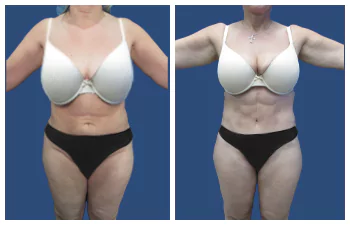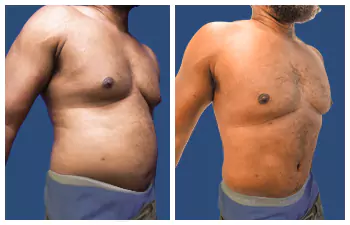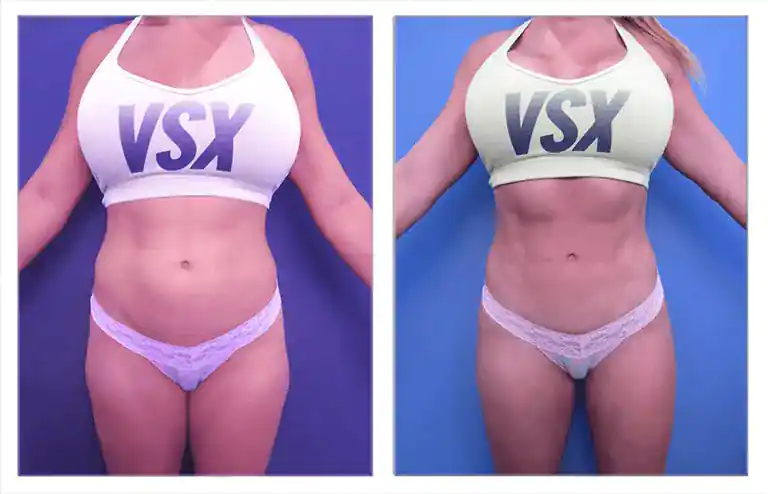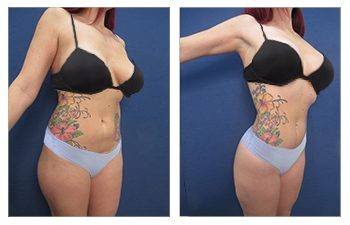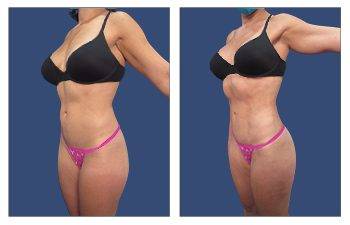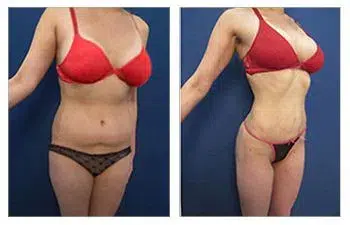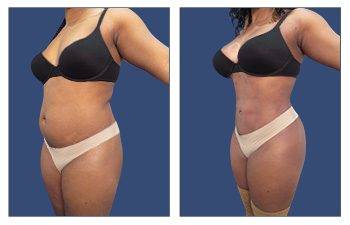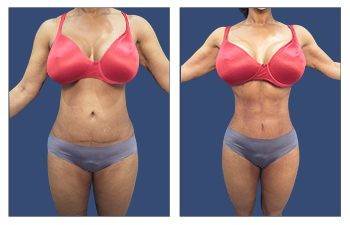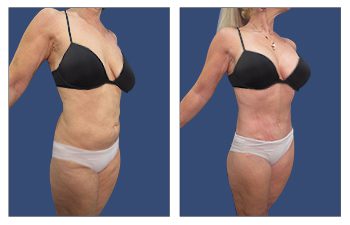What Is a Muffin Top?
A muffin top refers to the dreaded overhanging fat that spills over the waistband of tight jeans or pants, resembling the top of a muffin. This often occurs when excess fat accumulates around the mid-section, and can be a result of various factors such as genetics, aging, poor diet, lack of exercise, or hormonal changes. While it is a common concern for many people, it can also be a source of discomfort and self-consciousness. Understanding the causes and ways to address a muffin top can help individuals take steps toward achieving a healthier and happier lifestyle.
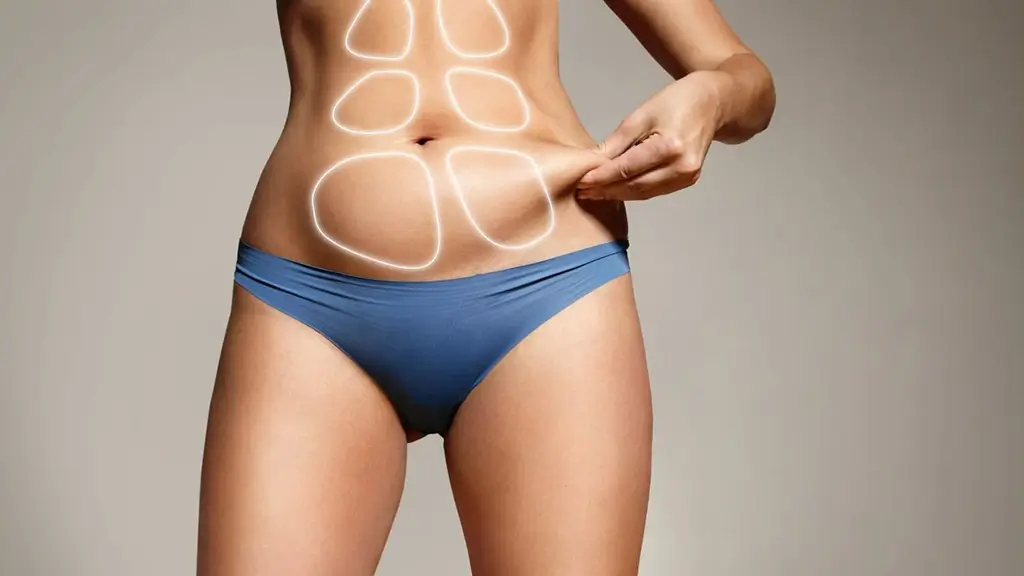
There are two main types of fat that contribute to the appearance of a muffin top: subcutaneous fat and visceral fat. Subcutaneous fat is the fat located just beneath the skin, while visceral fat is the fat that surrounds the internal organs. Both types of fat can contribute to the expansion of the waistline and the presence of a muffin top.
In addition to excess fat, loose skin can also contribute to the appearance of a muffin top. This can occur after significant weight loss or as a natural part of the aging process.
Overall, a muffin top is caused by an increase in body fat, particularly subcutaneous and visceral fat, as well as loose skin. It is important to maintain a healthy diet and exercise regimen to reduce the appearance of a muffin top and improve overall health.
What Causes a Muffin Top?
A muffin top, also known as a love handle, is a common problem that many people face. This excess fat around the waistline can be frustrating and can be caused by a combination of factors such as poor diet, lack of exercise, hormonal changes, genetics, and aging. Understanding the causes of a muffin top can help individuals take the necessary steps to prevent and reduce its appearance. By addressing these factors, individuals can work towards achieving a slimmer and trimmer waistline.
Diet
High-calorie ingredients to avoid include processed sugars and refined grains, such as white bread and sugary cereals. Healthier alternatives are whole grains like quinoa and brown rice, as well as natural sweeteners like honey or maple syrup.
Incorporating regular servings of fruits and lean protein like fish and chicken breast into your diet can help you feel full without overeating. Fruits are high in fiber, which aids in digestion and helps you feel full for longer periods. Lean protein is also filling and helps to build and repair muscle.
By making these changes to your diet, you can contribute to reducing fat storage around the midsection. Processed sugars and refined grains can lead to insulin spikes, which can increase fat storage around the belly. By replacing these with healthier alternatives and incorporating more fruits and lean protein, you can help stabilize your blood sugar levels and reduce fat storage in the midsection.
Overall, by avoiding high-calorie ingredients and choosing healthier alternatives, as well as including regular servings of fruits and lean protein, you can feel full without overeating and reduce fat storage around the midsection.
Heredity
Heredity plays a crucial role in determining fat storage and directly impacts weight loss. Our genetic makeup influences where and how our body stores fat, making some individuals more prone to accumulating excess fat than others. Genetic factors such as variations in the FTO gene and the MC4R gene have been linked to increased fat storage and obesity.
Although genetics cannot be controlled, healthy eating and exercise can help in reducing fat. While we cannot change our genes, we can make lifestyle choices that can influence how our genes are expressed. Regular physical activity and a balanced diet can help in managing weight and reducing fat storage, even for individuals with a genetic predisposition to obesity.
In conclusion, heredity can determine fat storage through genetic factors, but lifestyle choices such as healthy eating and exercise can help in reducing fat. Understanding the role of genetics in fat storage can inspire individuals to make positive lifestyle changes to manage weight and maintain overall health.
Stress
To manage stress, it’s important to incorporate stress-reducing activities into your daily routine. One effective way to do this is through meditation. Find a quiet space and take a few minutes each day to clear your mind, focus on your breathing, and practice mindfulness. Additionally, regular exercise can help reduce stress and improve your mood. Whether it’s a brisk walk, a yoga class, or a workout at the gym, physical activity can help release built-up tension and promote relaxation.
Spending time with loved ones is another important stress-reducing activity. Whether it’s a phone call, a coffee date, or a family dinner, connecting with others can provide emotional support and a sense of belonging. Prioritizing enough sleep is also crucial for managing stress, as lack of sleep can exacerbate anxiety and make it more difficult to cope with everyday challenges.
Practicing mindfulness throughout the day can also help reduce anxiety and prevent emotional eating. Take time to be present in the moment, pay attention to your thoughts and feelings, and engage in activities that bring you joy and relaxation. By incorporating these stress-reducing activities into your daily routine, you can better manage stress and improve your overall well-being.
Lack of exercise
If you are dealing with a lack of exercise in your daily routine, it’s important to start incorporating daily physical activity to improve your overall health. Aim for at least 30 minutes of exercise each day, whether it’s through high-intensity interval training (HIIT), barre, dancing, or boxing. These activities are effective in burning off excess fat and improving cardiovascular health.
To prevent boredom and keep yourself engaged, make sure to include a variety of activities in your routine. This could mean doing HIIT workouts on some days and switching it up with a barre or boxing class on other days. Dancing is another fun and effective way to get your heart rate up and stay active.
By incorporating daily physical activity into your routine, you can combat the negative effects of a sedentary lifestyle, improve your overall health, and maintain a healthy weight. Remember to start slow and gradually increase the intensity of your workouts to avoid injury.
Not enough sleep
Getting enough sleep is crucial for preventing muffin tops and maintaining a healthy weight. Lack of sleep can disrupt hormones that regulate appetite, leading to increased cravings for high-calorie foods and reduced motivation to exercise. This can result in weight gain and contribute to the development of muffin tops.
To improve sleep quality, it’s important to establish a consistent bedtime routine. This can include activities like reading, taking a warm bath, or practicing relaxation techniques. Cutting back on caffeine in the afternoon and evening can also help, as caffeine can interfere with the ability to fall asleep. Additionally, avoiding screens before bed is recommended, as the blue light emitted by electronic devices can disrupt the natural sleep-wake cycle.
The recommended sleep duration for adults is 7-9 hours per night. Sleep deprivation can have significant effects on weight gain and fat storage, as it can lead to increased levels of the stress hormone cortisol, which can promote fat accumulation around the abdomen. In order to prevent muffin tops and maintain a healthy weight, prioritizing good sleep hygiene is essential.
Hormones
Hormonal changes can significantly impact weight, skin, and hair density in women. Fluctuations in hormones, such as estrogen and progesterone, can lead to weight gain, acne breakouts, and changes in hair thickness and texture. For example, a decrease in estrogen levels can lead to an increase in body fat, particularly around the abdomen. Hormonal imbalances can also trigger an overproduction of sebum, leading to oily skin and acne. Additionally, changes in hormones can result in hair thinning or loss.
Common causes of hormonal changes include puberty, pregnancy, menopause, and certain medical conditions such as polycystic ovary syndrome (PCOS) and thyroid disorders. Stress, poor nutrition, and lack of exercise can also contribute to hormonal imbalances.
Addressing long-term hormone imbalances may involve lifestyle changes, such as maintaining a healthy diet, regular exercise, and stress management. Additionally, hormonal therapy, including birth control pills or hormone replacement therapy (HRT), may be prescribed by healthcare professionals to regulate hormone levels and alleviate symptoms. Consulting with a healthcare provider is crucial for identifying the underlying causes of hormonal changes and developing a personalized treatment plan.
Aging
As we age, our metabolism tends to slow down, making it easier for excess calories to be stored as fat, particularly around the midsection. Additionally, the production of collagen and elastin, which are essential for maintaining skin elasticity and firmness, decreases with age. This can lead to a loss of skin tightness and contribute to the appearance of excess belly fat.
Furthermore, as we age, the size of our fat cells tends to increase, especially in the abdominal area. This can result in the development of a “muffin top,” where fat spills over the waistband of clothing. The combination of a slower metabolism, decreased collagen and elastin production, and larger fat cells can contribute to skin laxity and the accumulation of excess belly fat.
Overall, the aging process can have a significant impact on the development of a muffin top, as it affects both the metabolism and the structural components of the skin, leading to decreased skin firmness and the appearance of excess fat in the abdominal region.
Insulin Resistance
In order to improve insulin resistance, it is crucial to incorporate regular exercise, maintain a healthy diet, and manage stress levels. Regular exercise, including a combination of aerobic and strength training, can help reduce abdominal fat, which is strongly associated with insulin resistance. It is also important to consume foods that are low in sugar and refined carbohydrates, as these can spike blood sugar levels and contribute to insulin resistance.
Incorporating stress management techniques, such as meditation, yoga, or deep breathing exercises, can also help improve insulin sensitivity and reduce inflammation in the body. Managing stress levels is key in improving insulin resistance, as chronic stress can lead to increased blood sugar levels and insulin resistance. By focusing on regular exercise, a healthy diet, and stress management, individuals can work to improve their insulin resistance and overall health.
Is a Muffin Top a Health Risk?
A muffin top, the extra fat around the waistline, is not just a cosmetic concern but also poses significant health risks. This excess fat is often a result of visceral fat, which is stored deep within the abdominal cavity and can surround vital organs. Visceral fat has been linked to an increased risk of chronic diseases such as cancer, heart disease, and type-2 diabetes.
Losing a muffin top can be challenging, as it requires a multi-channel weight-loss approach. This includes a balanced and healthy diet, regular exercise, adequate sleep, and stress reduction. Focusing on just one aspect, such as diet or exercise, may not be as effective in reducing visceral fat and achieving overall weight loss goals.
A healthy diet rich in nutrient-dense foods, such as fruits, vegetables, lean proteins, and whole grains, can aid in reducing visceral fat. Additionally, stress reduction techniques such as yoga, meditation, or mindfulness practices can help lower cortisol levels, which contribute to the accumulation of visceral fat. By adopting a holistic approach to weight loss that includes stress reduction, individuals can effectively reduce their muffin top and lower their risk for associated health issues.
Best Exercises to Get Rid of a Muffin Top
Tired of dealing with that stubborn muffin top? Fear not, as we’ve compiled the best exercises to help you finally get rid of it and achieve a more toned and sculpted waistline. Say goodbye to that pesky overhang and hello to a more confident and streamlined silhouette with these effective exercises targeted at blasting away the muffin top for good. Whether you prefer to work out at home or at the gym, these exercises are sure to help you reach your goal of banishing that muffin top once and for all. Get ready to sweat and see results with these top exercises for a slimmer waistline.
1. Single-Leg Glute Bridge
The single-leg glute bridge is an effective exercise for targeting the glutes, hamstrings, and core muscles. To perform this exercise with proper form, begin by lying on your back with your knees bent and feet flat on the ground. Extend one leg straight out in front of you. Place your arms by your sides with your palms facing down.
Engage your core and glutes as you lift your hips off the ground, keeping your extended leg in line with your other knee. It’s important to keep your hips parallel throughout the movement and to prevent your lower back from arching. Your body should form a straight line from your shoulders to your extended knee.
Lower your hips back down to the ground with control and repeat the movement for the recommended number of reps before switching to the other leg.
Maintaining proper form is crucial to avoid injury and fully engage the targeted muscles. Remember to focus on engaging your core and glutes, keeping your hips parallel, and preventing any arching in the lower back.
Incorporating the single-leg glute bridge into your workout routine can help improve your lower body strength, stability, and overall athletic performance.
2. Mountain Climber Twist
To perform the Mountain Climber Twist exercise, start in a high plank position with your hands directly under your shoulders and your body forming a straight line from head to heels. Engage your core to keep your hips level and prevent any sagging or arching in your back.
Next, bring your right knee towards your left elbow, twisting your torso as you do so. Return to the high plank position and then bring your left knee towards your right elbow, again twisting your torso. Alternate between bringing each knee towards the opposite elbow in a controlled and deliberate manner to target the oblique muscles.
Proper form is crucial in this exercise to effectively work the obliques and reduce the appearance of a muffin top. It’s important to maintain a stable plank position and avoid any unnecessary movement in your hips or upper body. Focus on controlled movements and engaging the oblique muscles with each twist.
For best results, perform 3 sets of 12-15 reps on each side, taking a brief rest between sets. Incorporating the Mountain Climber Twist into your regular workout routine can help strengthen the oblique muscles and reduce the appearance of a muffin top when combined with a healthy diet and overall fitness plan.
3. Superman
The Superman exercise is an effective core exercise that targets the lower back and glutes to help strengthen these areas. To perform the Superman exercise, start by lying face down on a mat with your arms extended in front of you and your legs straight behind you.
From this starting position, engage your core muscles and lift your arms, chest, and legs off the ground at the same time. Imagine you are trying to lengthen your body as much as possible. Hold this position for a few seconds, then slowly lower back down to the starting position.
For optimal results, aim to perform 2-3 sets of 10-15 repetitions of the Superman exercise. Remember to focus on controlled movements and proper form to avoid straining your muscles. This exercise is a great way to build strength in your core, lower back, and glutes, and can be easily incorporated into your regular workout routine. Start with a manageable number of repetitions and sets, and gradually increase as your strength and endurance improve. Add the Superman exercise to your workout routine to effectively target and strengthen your core, lower back, and glutes.
4. Russian Twist
The Russian Twist exercise is an effective way to target the obliques and strengthen the core. To perform this exercise, start in a seated position with your knees bent and feet flat on the floor. Lean back slightly, keeping your back straight, and clasp your hands together in front of you. Engage your core and lift your feet off the ground, balancing on your glutes. Slowly twist your torso to the right, then back to the center, and then to the left, while keeping your arms straight. You can also vary the intensity by holding a weight or medicine ball.
To intensify the core activation, focus on slowing down the movement and maintaining control. Avoid using momentum to swing the arms, as this can reduce the effectiveness of the exercise. Additionally, be mindful of keeping your back straight and not hunching over, as this can lead to strain on the lower back. For those at different fitness levels, you can modify the exercise by keeping the feet on the ground or using lighter weights.
Proper form and technique are crucial for maximizing the effectiveness of the Russian Twist. By emphasizing proper arm and trunk movement, you can ensure that the exercise targets the intended muscle groups and helps to avoid injury. Remember to engage the core throughout the movement and focus on controlled twists to see the best results from this exercise.
5. Side Plank
To perform a side plank, start by lying on your side with your legs straight and stacked on top of each other. Place your elbow directly beneath your shoulder and prop yourself up so that your body forms a straight line from your head to your ankles. Engage your core muscles and lift your hips off the ground, keeping your body in a straight line. Hold this position for 15-30 seconds, or as long as you comfortably can, while maintaining proper form and engaging your core to support your body. After completing the desired time, lower your hips back to the ground and repeat on the other side.
It is crucial to emphasize the importance of engaging your core muscles throughout the entire exercise and maintaining a straight line from your underarm to your ankle. This ensures that you are effectively targeting your core and avoiding any strain on other muscles. Perform 2-3 sets of 8-12 repetitions on each side, focusing on maintaining proper form and engaging your core throughout. By practicing this exercise on both the right and left sides, you can ensure balanced strength and stability in your core muscles. The side plank is a great exercise for building core strength and stability in the body.
6. Lunge to Overhead Press
The lunge to overhead press exercise is a compound movement that combines the lower body strength of a lunge with the upper body strength of an overhead press using dumbbells. This exercise not only targets multiple muscle groups but also requires core engagement for stability throughout the movement.
To begin, stand with your feet hip-width apart, holding a dumbbell in each hand at shoulder height. Step forward into a lunge position, making sure to keep your front knee directly above your ankle and not allowing it to go past your toes. As you lunge down, lower the dumbbells to either side of your front foot. Then, push through your front heel to return to the starting position, while simultaneously pressing the dumbbells overhead. Engage your core throughout the movement to maintain stability.
Key points for completing a repetition include keeping the chest up, shoulders back, and maintaining a neutral spine. Aim for 3-4 sets of 10-12 repetitions on each leg, with a focus on controlled and deliberate movements to maximize the effectiveness of the exercise. By incorporating the lunge to overhead press into your workout routine, you can target both your lower and upper body while also engaging your core for stability.
Surgical Guide to Removing a Muffin Top
Struggling with stubborn belly fat that seems to hang over your jeans? The first line of action to reduce your muffin top is a healthy diet and exercise to targeted nutrition, these strategies will help you say goodbye to that unsightly overhang and hello to a more confident silhouette. Whether you’re looking to lose weight, improve your diet, or simply firm up your stomach, exercise and lifestyle changes will provide you with the tools you need to finally conquer your muffin top. However, if you have struggled with reducing your muffin top, then surgery provides an effective alternative. Whereas lifestyle changes only will help you lose your visceral fat, surgery is an effective approach to eliminating your superficial fat and skin redundancy.
A muffin top, the colloquial term for the overhang of fat and skin above the waistline, is not only a cosmetic concern but also a health issue. Surgical correction offers a solution to this problem, providing both aesthetic and health benefits. The most common surgical procedures for addressing a muffin top are liposuction, tummy tuck (abdominoplasty), and laser therapy.
Liposuction
Liposuction is a popular choice for those who are close to their ideal body weight but are struggling with stubborn areas of fat that do not respond to diet and exercise. This procedure involves making small incisions through which a thin tube, or cannula, is inserted to loosen and suction out fat. The advantage of liposuction lies in its ability to precisely target specific areas, providing a more contoured and flattering silhouette. However, it is important to note that liposuction is not a weight-loss solution but rather a body contouring tool. The risks associated with liposuction include bruising, swelling, and potential asymmetry in the contour of the treated area.
Tummy Tuck (Abdominoplasty)
Tummy Tuck is a more extensive procedure recommended for individuals who have excess skin in addition to fat around the abdomen. This procedure involves a horizontal incision along the lower abdomen through which excess skin and fat are removed. The abdominal muscles may also be tightened during a tummy tuck, which can benefit those who have experienced muscle separation due to pregnancy or significant weight fluctuations. A tummy tuck offers a dramatic transformation, not only eliminating the muffin top but also flattening and enhancing the overall shape of the abdomen. The recovery period for a tummy tuck is longer than that of liposuction, and patients should be prepared for a significant healing process, which includes managing discomfort and a period of restricted activity.
Laser Therapy
Laser therapy is a minimally invasive option that uses laser energy to target fat cells. This procedure is ideal for patients who prefer a less invasive approach and have smaller areas of fat to be addressed. The laser not only helps in breaking down the fat cells but also stimulates collagen production, which can result in tighter skin. Recovery from laser therapy is typically quicker than that of more invasive surgeries, with less downtime and fewer risks. However, the results may be less dramatic compared to liposuction or a tummy tuck.
When considering surgical options for eliminating a muffin top, it is crucial to consult with a qualified and experienced surgeon. The choice of procedure will depend on the individual’s body type, the amount of correction needed, and personal health and aesthetic goals. It is also important to maintain realistic expectations about the results and understand that maintaining a healthy lifestyle post-surgery is key to long-lasting results.
Conclusion: Muffin Top
In summary, a muffin top affects patients throughout the world especially those with weight fluctuations or unhealthy diet and lifestyle. Others may just develop a muffin top because of poor genetics or illnesses. Regardless, lifestyle improvements such as consuming a healthy diet and more active choices will often improve the appearance of your muffin top. If lifestyle improvements hail to improve your appearance, then you may elect to undergo muffin top surgery. We hope that you find this article regarding muffin top corrections helpful.



